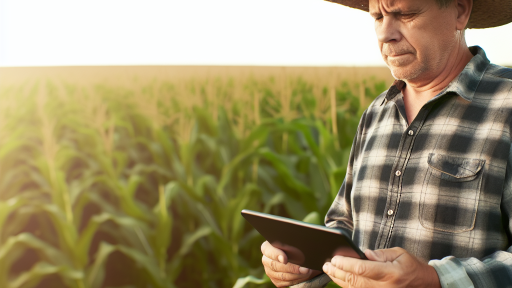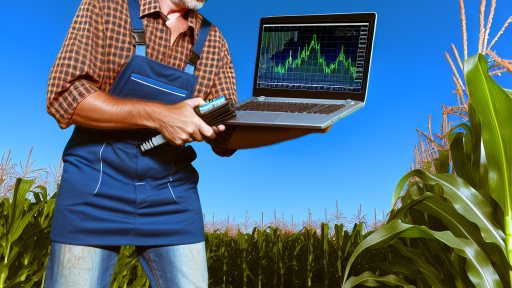Introduction
Definition and Overview of Vertical Farming
Vertical farming, growing crops in stacked layers, enables vertical farming disrupting traditional agribusiness models.
It uses controlled-environment agriculture technology to optimize plant growth.
This method allows farmers to produce food in urban spaces, reducing the need for expansive land areas.
Vertical farms often utilize hydroponics, aeroponics, or aquaponics.
These techniques enable plants to grow in nutrient-rich solutions or air without soil.
History of Farming Methods and Emergence of Vertical Farming
Traditional farming has dominated food production for centuries.
Farmers relied on vast fields, seasonal weather patterns, and natural soil fertility.
However, urbanization and population growth increased the demand for innovative agricultural solutions.
In the late 20th century, researchers began exploring vertical farming concepts.
They recognized the potential for efficiency and sustainability in urban settings.
Pioneers like Dr. Dickson Despommier popularized vertical farming through academic research and advocacy.
The first commercial vertical farms appeared in the early 2000s, marking a significant shift in agricultural practices.
Importance of the Topic in the Context of Modern Agriculture and Food Production
Vertical farming offers a sustainable alternative to conventional agriculture.
It addresses critical challenges such as land scarcity, climate change, and food security.
Urban populations face increasing food needs while traditional farming struggles with limited arable land.
Vertical farms reduce transportation costs and carbon footprints by producing food closer to consumers.
They also enable year-round production, independent of weather fluctuations.
Furthermore, vertical farming utilizes less water compared to traditional methods, ensuring resource efficiency.
By incorporating technology, vertical farms can monitor plant health and optimize yields.
This innovative approach plays a vital role in reshaping food systems for the future.
Thus, vertical farming is crucial for addressing the challenges of modern agriculture and ensuring a stable food supply.
Traditional Agribusiness Models
Description of Conventional Farming Practices
Conventional farming practices have shaped global agriculture for centuries.
These practices primarily revolve around cultivating crops and raising livestock.
Farmers rely heavily on machinery and chemical inputs.
They use tractors for plowing, sowing, and harvesting.
Fertilizers and pesticides enhance crop yields.
However, these practices often have environmental implications.
- Crop Rotation: Farmers rotate different crops each season to maintain soil health.
- Monoculture: This involves planting a single crop over a large area.
It can lead to increased efficiency but depletes soil nutrients. - Soil Tilling: Tilling breaks up soil but can lead to erosion and loss of soil structure.
- Water Management: Traditional methods often rely on irrigation systems and rain-fed water sources.
- Animal Husbandry: Livestock farming includes raising cattle, pigs, and poultry for meat, dairy, and eggs.
Although these conventional methods have been staples of agribusiness, they also create challenges that lead to calls for innovation.
Overview of Supply Chain Dynamics in Traditional Agriculture
The supply chain in traditional agriculture consists of several crucial stages.
Each stage plays a distinct role in getting products from the farm to consumers.
Understanding this supply chain helps illustrate the complexities faced by traditional farmers.
- Inputs: Farmers purchase seeds, fertilizers, and equipment from suppliers.
- Production: Farmers grow crops or raise animals, depending on their focus.
- Harvesting: Once the crops are ready, farmers harvest them.
Timing is crucial to maximize yield. - Processing: After harvest, some crops undergo processing before reaching consumers.
- Distribution: This stage includes transporting goods via trucks, ships, or trains.
- Retail: Products finally reach grocery stores or markets for consumer purchase.
The supply chain is often lengthy and can lead to increased costs and waste.
It relies heavily on natural cycles, making it vulnerable to external factors.
Challenges Faced by Traditional Farms
Traditional farms encounter numerous challenges that hinder productivity and sustainability.
These challenges can affect everything from profitability to environmental impact.
- Land Use: Expanding urbanization reduces available farmland.
As cities grow, the competition for land intensifies. - Water Scarcity: Traditional farming often requires significant water use.
Regions suffering from drought face heightened risk. - Transportation Issues: Delivering goods from farms to markets incurs high transportation costs.
Poor infrastructure can delay deliveries, leading to spoilage. - Market Access: Small farmers struggle to access larger markets.
They often remain reliant on local cooperatives or middlemen. - Labor Shortages: Rural populations decline as younger generations migrate to urban areas.
This trend results in labor shortages for traditional farms. - Climate Change: Altered weather patterns affect crop yields.
Unpredictable seasons lead to planting and harvesting challenges. - Pest and Disease Management: Conventional farmers battle pests and diseases using chemicals.
Resistance can build up, making these methods less effective over time.
Overall, these challenges have jeopardized the sustainability and profitability of traditional agribusiness models.
As a result, the industry faces mounting pressures to adapt.
Key Features of Vertical Farming
Technology Integration (Hydroponics, Aeroponics, and Aquaponics)
Vertical farming utilizes advanced technologies to maximize crop production in limited spaces.
Three primary systems drive this innovation: hydroponics, aeroponics, and aquaponics.
- Hydroponics: This system uses nutrient-rich water to grow plants without soil.
It enhances growth rates and conserves resources. - Aeroponics: In this technique, plants grow in an air or mist environment, receiving nutrients directly.
This method uses even less water than hydroponics. - Aquaponics: This system combines fish farming with plant cultivation.
Fish waste provides nutrients for the plants, creating a symbiotic environment.
These technologies allow vertical farms to operate efficiently.
Each method also supports precision agriculture, which optimizes input usage.
Farmers can monitor and adjust every aspect of plant growth, ensuring maximum yield.
The integration of sensors and data analytics further enhances these technologies.
Farmers can track temperature, humidity, and nutrient levels in real-time.
This information helps in making informed decisions, driving higher productivity rates.
Moreover, automation plays a crucial role in vertical farming.
Automated systems can handle planting, watering, and harvesting.
This reduces the labor costs associated with traditional agriculture and minimizes human error.
Space Optimization and Urban Agriculture
Space optimization defines another key feature of vertical farming.
As urbanization increases, traditional farmland becomes scarce.
Vertical farming addresses this challenge effectively.
- Multi-Story Structures: Vertical farms often occupy multi-story buildings.
This approach allows for higher crop density in urban settings. - Rooftop Farms: Transforming rooftops into farms utilizes otherwise unused space.
This practice integrates agriculture into city landscapes. - Modular Design: Many vertical farms adopt modular setups.
This flexibility enables farmers to scale operations easily.
Urban agriculture through vertical farming offers numerous benefits.
Neighborhoods gain access to fresh produce, promoting healthier eating habits.
Additionally, local food production reduces transportation costs and emissions.
Transform Your Agribusiness
Unlock your farm's potential with expert advice tailored to your needs. Get actionable steps that drive real results.
Get StartedFurthermore, vertical farms significantly decrease water usage.
Traditional agriculture consumes large amounts of water, while vertical systems recycle water efficiently.
This conservation is crucial in areas facing water scarcity.
Vertical farming also helps address food deserts in urban areas.
Many neighborhoods lack access to fresh fruits and vegetables.
By establishing vertical farms in these regions, communities can enhance food security.
Sustainability Practices and Reduction of Environmental Impact
Sustainability practices lie at the heart of vertical farming.
As traditional farming contributes to environmental degradation, vertical farming aims to reverse this trend.
- Reduced Land Use: Vertical farms require significantly less land than traditional farms.
This practice helps preserve natural habitats. - Lower Carbon Footprint: By growing food locally, vertical farming reduces greenhouse gas emissions from transportation.
- Energy Efficiency: Many vertical farms utilize renewable energy sources, such as solar power.
This commitment further decreases their environmental impact. - Organic Practices: Vertical farming often emphasizes organic methods.
Farmers can grow pesticide-free produce, benefiting the ecosystem.
Vertical farming also minimizes soil degradation and erosion, common issues in traditional agriculture.
By leveraging non-soil growing methods, vertical farms protect the integrity of the land.
The reduction of food waste is another critical sustainability aspect.
Vertical farms can be placed closer to consumers, ensuring produce remains fresh.
This proximity reduces spoilage and waste, contributing to a circular economy.
Lastly, vertical farming promotes biodiversity.
Varied species can coexist in controlled environments, unlike monoculture practices in traditional farming.
This diversity contributes to more resilient ecosystems.
In essence, vertical farming integrates technology through hydroponics, aeroponics, and aquaponics.
These systems maximize crop yields while utilizing limited urban spaces.
They promote sustainability by reducing environmental impacts and conserving resources.
As cities continue to grow, vertical farming presents a viable solution to food production challenges.
This innovative approach transforms not only how we grow food but also where we grow it.
By investing in vertical farming, we embrace a sustainable future for agriculture.
Read: How to Scale Your Agribusiness for Maximum Revenue
Economic Disruption in Agribusiness
Cost Efficiency and Profitability in Vertical Farming
Vertical farming reshapes the economic landscape of agribusiness.
This innovative approach minimizes land usage, leading to cost efficiency.
Here are some key financial advantages of vertical farming:
- Reduced Land Costs: Urban areas, where land is scarce and expensive, benefit from vertical farming’s space-saving techniques.
Transforming warehouses into farms cuts land acquisition costs significantly. - Lower Transportation Expenses: Proximity to metropolitan markets decreases transportation costs.
Delivering fresh produce locally enhances profitability while reducing carbon footprints. - Controlled Environment: Vertical farms employ technology to control light, temperature, and humidity.
This optimizes growing conditions year-round, increasing yields and minimizing crop losses. - Water Efficiency: These farms use hydroponic and aeroponic systems, which consume less water than traditional farming.
This leads to substantial cost savings and sustainable practices. - Consistent Crop Production: With controlled conditions, farmers can produce crops continuously.
This reliability enhances market supply, stabilizing prices and boosting income.
These advantages result in higher profit margins compared to conventional farming methods.
As a result, agribusinesses are increasingly adopting vertical farming practices.
They seek to remain competitive in a rapidly changing marketplace.
Changes in Employment Opportunities and Labor Dynamics
The rise of vertical farming transforms labor dynamics within the agricultural sector.
Traditional farming relies heavily on manual labor, while vertical farming incorporates advanced technology.
This shift leads to the following trends in employment:
- Technological Skills Demand: Vertical farms require employees skilled in operating and maintaining automated systems.
Knowledge of robotics, data analysis, and system management is essential. - Fewer Laborers Needed: Automation reduces the number of manual labor positions.
Vertical farms can produce the same output with fewer employees, reshaping the labor market. - Seasonal Employment Reduction: With year-round production, fewer seasonal jobs exist.
This stability benefits workers, providing reliable employment instead of fluctuating seasonal roles. - Increased Collaboration: Vertical farming often involves collaboration between various professionals.
Agronomists, engineers, and food scientists work together, promoting interdisciplinary opportunities. - Focus on Research and Development: As vertical farming evolves, new job markets for R&D emerge.
Companies need researchers to innovate and enhance farming technologies continually.
This evolution creates a workforce that is not only tech-savvy but also adaptable.
Employers seek individuals who can keep pace with the rapid advancements in agricultural techniques and technology.
Impact on Agricultural Subsidies and Government Policies
The rise of vertical farming carries significant implications for agricultural subsidies and government policies.
Traditional agriculture has long received financial support from governments worldwide.
Vertical farming presents challenges and opportunities for these policies:
- Reevaluation of Subsidy Structures: Governments may need to reassess their subsidy programs.
Supporting vertical farming might require redirecting funds from conventional farming practices. - Incentives for Sustainable Practices: Vertical farms generally promote sustainability solutions.
Governments could incentivize operations that minimize carbon footprints and conserve water. - Urban Agriculture Policies: As vertical farms focus on urban areas, cities may introduce specific regulations.
Zoning laws and building codes will need adjustments to accommodate these innovative farms. - Research Funding: Governments might increase research grants for vertical farming innovations.
Support for technology and infrastructure development can drive further advancements. - Food Security Initiatives: Vertical farming can enhance food security in urban centers.
Policymakers may prioritize funding programs that promote local food production.
This evolution in agricultural policies will greatly influence how agribusinesses operate in the coming years.
Governments must strike a balance between supporting traditional farmers and fostering new technologies.
In fact, vertical farming is more than a trend; it represents a significant shift in agribusiness economics.
Its cost efficiency and profitability reshape market dynamics.
Labor market changes challenge traditional employment structures while fostering new opportunities.
Finally, the impact on government policies and subsidies will redefine the agricultural landscape.
As this innovative approach grows, it will continue to disrupt agribusinesses, paving the way for a sustainable farming future.
Read: Proven Agribusiness Strategies for Maximum Profit

Environmental and Social Implications
Reduction in carbon footprint and resource usage
Vertical farming significantly reduces the carbon footprint associated with traditional agriculture.
It minimizes the distance food travels from farm to table.
This local production method limits emissions from transportation.
Vertical farms often use renewable energy sources, further decreasing carbon output.
Additionally, vertical farming optimizes resource usage.
It employs hydroponics and aeroponics systems that use up to 90% less water compared to traditional farming.
This key reduction is crucial in water-scarce regions and during drought periods.
Vertical farms also utilize recycled water, further conserving this precious resource.
The energy consumption of vertical farming is efficient.
While indoor farms require lighting, advances in LED technology have greatly reduced energy demands.
These lights provide the necessary wavelengths for plant growth while using less electricity.
Many vertical farms also implement energy-efficient climate control systems to further decrease their energy needs.
Moreover, soil degradation typically associated with traditional farming methods is not a concern in vertical farming.
Since these systems do not rely on soil, they alleviate the pressure on natural ecosystems.
This shift preserves soil health and biodiversity, promoting a more sustainable agricultural model.
- Local production reduces transportation emissions.
- Uses up to 90% less water than conventional farming.
- Employs renewable energy sources to decrease carbon output.
- Utilizes advanced LED lighting to minimize energy consumption.
- Preserves soil health by eliminating the need for soil.
Contribution to food security and local communities
Vertical farms play a vital role in enhancing food security worldwide.
As urban populations increase, demand for fresh produce rises.
Vertical farming provides a sustainable solution to this issue by producing food in metropolitan areas.
These farms can supply fresh produce year-round, regardless of weather conditions.
By growing food closer to consumers, vertical farming reduces reliance on long supply chains.
This accessibility also means that communities are less affected by food shortages and fluctuations in food prices.
Moreover, vertical farms create jobs and stimulate local economies.
They offer employment opportunities ranging from agricultural technicians to management roles.
These jobs are crucial in urban areas, where unemployment rates may be higher.
Showcase Your Farming Business
Publish your professional farming services profile on our blog for a one-time fee of $200 and reach a dedicated audience of farmers and agribusiness owners.
Publish Your ProfileLocal communities benefit from increased access to nutritious food.
Vertical farms often focus on growing leafy greens and other highly nutritious crops.
This focus helps combat food deserts, areas lacking affordable and healthy food options.
- Enhances food security in urban areas.
- Provides year-round access to fresh produce.
- Reduces dependency on long supply chains.
- Creates various job opportunities in urban settings.
- Helps address food deserts with nutritious options.
Addressing urbanization and population growth challenges
Urbanization presents various challenges for food production.
As cities expand, arable land becomes scarce.
Vertical farming addresses this challenge by utilizing underused urban spaces, such as rooftops and abandoned warehouses.
This innovative approach allows cities to grow more food within their boundaries.
Vertical farms can be integrated into urban planning, ensuring food production becomes a part of city infrastructures.
As a result, they create green spaces that enhance urban landscapes and contribute to environmental sustainability.
Vertical farming inherently supports population growth sustainability.
With the global population projected to reach 9.7 billion by 2050, food demand will increase dramatically.
Vertical farming can meet this demand without expanding agricultural land.
By utilizing vertical space, farms can grow more food with fewer resources.
Additionally, vertical farms can quickly adapt to changing consumer preferences.
As trends shift toward locally-sourced and organic produce, these farms can adjust their crops easily.
This agility ensures that they address the needs of urban populations effectively.
- Utilizes underused urban spaces for food production.
- Integrates food production into city infrastructure.
- Addresses the need for sustainability amid population growth.
- Adapts quickly to changing consumer preferences.
- Contributes to the development of urban green spaces.
Therefore, vertical farming represents a revolutionary shift in agricultural practices.
By prioritizing environmental sustainability, food security, and urban needs, vertical farms disrupt traditional agribusiness models.
These farms not only contribute to ecological preservation but also enhance local economies and food accessibility.
As we face the challenges presented by urbanization and population growth, vertical farming solutions will become increasingly vital.
Their ability to produce food efficiently in urban landscapes makes them key players in the future of agriculture.
Embracing this technology can help societies build sustainable, resilient food systems for generations to come.
Read: Maximizing Profit: Selling Your Farm Land Wisely
Case Studies of Successful Vertical Farms
Examination of Leading Vertical Farming Companies
Vertical farming companies are at the forefront of agricultural innovation.
Two notable examples, AeroFarms and Plenty, illustrate the potential of this method.
- AeroFarms: Based in Newark, New Jersey, AeroFarms specializes in growing leafy greens.
They utilize aeroponic technology, which significantly reduces water usage.
Their indoor farms produce high yields in smaller spaces. - Plenty: Located in San Francisco, Plenty emphasizes vertical farming technology coupled with artificial intelligence.
They grow a variety of crops, focusing on optimizing plant growth and minimizing waste.
These companies exemplify how vertical farming can revitalize food production.
They represent a shift towards sustainable agriculture that meets urban demands.
Analysis of Their Business Models and Operational Strategies
Understanding the business models and operational strategies of AeroFarms and Plenty offers important insights into the industry’s dynamics.
- Revenue Streams: Both companies focus on direct-to-consumer sales, partnering with local grocery stores.
They emphasize freshness, growing produce close to urban centers. - Technology Utilization: AeroFarms uses advanced sensor technology.
This approach monitors plant health and optimizes water and nutrient delivery.
Plenty leverages AI for data-driven decision-making, predicting plant growth patterns. - Scalability: Their designs promote scalability. AeroFarms employs modular systems that can easily expand.
Plenty’s AI-driven processes allow for quick adaptations to changing market demands. - Environmental Sustainability: They significantly reduce resource consumption. AeroFarms claims to save 95% more water than traditional farms.
Plenty’s practices reduce the carbon footprint by eliminating transportation needs. - Community Engagement: Both firms actively engage with local communities.
They host educational programs to raise awareness about sustainable practices and healthy eating.
Their strategies highlight the interplay between technology, sustainability, and market needs.
This intersection proves vital for success in vertical farming.
Lessons Learned and Best Practices from These Case Studies
Analyzing the successes of AeroFarms and Plenty reveals key lessons beneficial to the vertical farming sector.
Here are several best practices derived from their experiences:
- Embrace Technology: Utilize cutting-edge technology.
Adopting AI and sensor technology enhances plant efficiency.
Continuous improvements in data analytics drive better decision-making. - Focus on Sustainability: Prioritize environmental health.
Sustainable practices, such as water recycling and energy-efficient lighting, should be standard.
These practices resonate well with eco-conscious consumers. - Adaptability is Crucial: Cultivate a culture of flexibility.
Being open to innovation allows vertical farms to respond to market changes.
Adapting quickly to supply chain disruptions ensures ongoing viability. - Engage with the Community: Foster community connections.
Building relationships with local organizations increases brand loyalty.
Educating consumers about vertical farming can drive demand. - Build Strategic Partnerships: Collaborate with other businesses.
Form partnerships with grocery chains or local restaurants to enhance market presence.
Sharing resources can reduce operational costs.
These lessons enhance operational efficiency and market viability.
Others in the vertical farming sector can adopt this knowledge to strengthen their endeavors.
The success stories of AeroFarms and Plenty demonstrate the disruptive potential of vertical farming.
Through innovative practices, these companies not only contribute to food security but also redefine agricultural landscapes.
As more urban areas seek sustainable solutions, vertical farming will likely play a pivotal role.
The integration of advanced technology, sustainable practices, and community engagement stands as a blueprint for future endeavors in the agricultural sector.
Read: Sustainable Practices in Farm-to-Market Chains
Future Trends in Vertical Farming
As we look ahead, vertical farming is poised to redefine agriculture.
Innovations in technology and farming techniques pave the way for unprecedented growth.
These advancements promise to solve many challenges faced by traditional farming methods.
Innovations in Technology and Farming Techniques
The future of vertical farming hinges on cutting-edge technology.
Several crucial innovations are shaping its direction:
- Smart Sensors: Smart sensors monitor plant health in real-time.
They collect data on humidity, temperature, and nutrient levels.
This data allows for precise adjustments. - Hydroponics and Aeroponics: These soilless farming methods utilize less water than traditional irrigation.
Hydroponics grows plants in nutrient-rich water, while aeroponics sprays nutrient solutions onto plant roots.
Both techniques promote faster growth rates. - LED Lighting: Advanced LED technology caters to specific wavelengths.
This boosts photosynthesis and yields while reducing energy costs.
LEDs also allow vertical farms to operate indoors, regardless of sunlight. - Artificial Intelligence (AI): AI improves decision-making in vertical farming.
It analyzes big data and optimizes growth conditions for each crop.
Moreover, AI can predict harvest times, maximizing efficiency. - Automation: Automated systems increase operational efficiency.
Robots can plant, monitor, and harvest crops with minimal human intervention.
Automation reduces labor costs and mitigates human error. - Vertical Growth Structures: Innovative racking systems maximize space utilization.
These structures allow plants to grow upward rather than outward.
Such designs optimize light exposure and airflow.
These innovations will drive the vertical farming industry forward.
The emphasis on data-driven solutions and sustainable practices makes vertical farming a viable alternative.
As technology evolves, vertical farms will become more efficient and productive.
Predicted Growth of Vertical Farming Globally and Regionally
The global landscape for vertical farming is rapidly expanding.
Experts predict substantial growth in both urban and rural areas:
- Market Value: The vertical farming market is anticipated to surpass $10 billion by 2025.
This is a significant increase from previous years, showcasing growing demand. - Regional Expansion: Regions with limited arable land, such as Asia and Europe, will lead growth.
Urban centers will continue adopting vertical farming to enhance food security. - Investment Surge: Venture capital funding for vertical farms has skyrocketed.
Investors recognize the potential for higher returns in this sustainable sector. - Job Creation: The rise of vertical farming will create numerous jobs.
Positions in engineering, tech support, and agronomy will be in demand.
These opportunities will shift workforce dynamics in traditional farming. - Consumer Demand: Health-conscious consumers will drive demand for fresh, local produce.
Vertical farms can provide fresh vegetables year-round, reducing reliance on long supply chains.
These trends indicate a robust future for vertical farming.
The industry’s growth is inevitable as it responds to pressing agricultural challenges.
It positions itself uniquely within the global food supply chain.
Potential for Vertical Farms to Complement or Replace Traditional Farms
Vertical farming holds significant potential to complement or even replace conventional farming.
This potential arises from numerous advantages vertical farms offer:
- Resource Efficiency: Vertical farms utilize significantly less water and land.
This makes them suitable for urban environments with limited space.
They can produce food efficiently in any location. - Year-Round Production: Vertical farms are not affected by seasonal changes.
They can grow crops continuously throughout the year.
This ensures a constant food supply, regardless of weather conditions. - Reduced Transportation Costs: By locating vertical farms closer to consumers, transportation needs decrease.
Decreasing the distance food travels reduces carbon emissions and spoilage. - Enhanced Crop Variety: Vertical farms can grow diverse crops in controlled environments.
This allows farmers to respond quickly to market demands.
Traditional farms typically grow seasonal crops with longer growing cycles. - Sustainability: Vertical farming practices promote sustainability.
They often rely on renewable energy sources, such as solar power.
This reduces the environmental footprint associated with food production. - Food Security: Urban vertical farms contribute to local food systems.
They help reduce dependency on distant suppliers.
Thus, they enhance food security in areas prone to supply disruptions.
As vertical farms become more prevalent, aspects of traditional farming will shift.
Farmers may adopt hybrid models that blend vertical and conventional methods.
This collaboration may yield the best outcomes for food production.
In short, the future of vertical farming appears bright and transformative.
We can expect rapid technological innovations coupled with significant market growth.
As urban populations swell, the need for efficient food production systems will intensify.
Vertical farming stands at the forefront, promising a sustainable, resilient agricultural future.
Challenges and Limitations of Vertical Farming
Vertical farming represents a revolutionary shift in agriculture, but significant challenges and limitations exist.
Understanding these issues is crucial for stakeholders exploring this innovative approach.
This section discusses key challenges which include initial investment costs, technical hurdles, and market acceptance among consumers.
Initial Investment Costs and Financing Hurdles
The initial investment required for vertical farms can be staggering.
Unlike conventional farms, they need advanced technology and infrastructure.
Here are some costs to consider:
- Equipment Costs: The cost of LED lighting, hydroponic systems, and climate control can reach millions.
- Building or Retrofitting Facilities: Constructing or adapting urban buildings increases capital outlay.
- Operational Costs: Energy expenses for lighting and climate control can be high, often demanding significant capital.
- Research and Development: Ongoing R&D is essential to improve efficiency and yields, further increasing initial investment.
Securing financing poses another hurdle.
Most traditional investors focus on conventional agriculture.
They may hesitate to fund vertical farms due to perceived risks.
Start-ups often rely on venture capital and public grants, but this isn’t always sufficient.
Limited access to financing restricts many entrepreneurs from entering the market.
Furthermore, they face pressure to demonstrate return on investment quickly, making it difficult to sustain operations long-term.
Technical Challenges and Knowledge Gaps
Vertical farming relies heavily on technology and precision agriculture practices.
While these innovations provide many advantages, they also create challenges.
- Technological Complexity: Implementing systems for lighting, irrigation, and nutrient delivery requires specialized knowledge.
- Skill Shortages: Many agricultural professionals lack the necessary skills for vertical farming, hampering development.
- System Failures: Technical malfunctions can result in crop loss, significantly impacting profitability.
- Data Management: Utilizing data analytics for monitoring growth and optimizing conditions requires advanced infrastructure.
Operational complexities increase the potential for errors.
If farmers don’t know how to maintain optimal growing conditions, it can hinder production.
Knowledge gaps can lead to poor crop quality, further complicating market access.
Many aspiring vertical farmers need comprehensive training programs.
Educational institutions must quickly adapt curriculums to prepare future farmers for these unique challenges.
Market Acceptance and Consumer Perceptions of Vertically Grown Produce
Consumer perception plays a crucial role in the success of vertical farming.
While urban populations increasingly seek local, fresh produce, some remain skeptical of vertical farming.
Understanding these perceptions can help vertical farmers tailor their marketing approaches.
Here are some factors influencing market acceptance:
- Familiarity: Consumers are more accustomed to traditional farming methods, creating skepticism toward novel approaches.
- Quality Concerns: Many worry that vertically grown produce lacks flavor and freshness compared to traditionally grown crops.
- Pricing Issues: Higher production costs can lead to increased retail prices, deterring budget-conscious consumers.
- Labeling Confusion: Consumers may find it difficult to understand terms like “hydroponic” or “aeroponic,” leading to mistrust.
Moreover, marketing vertical farming benefits requires educational initiatives.
Farmers must promote the advantages of vertical farming, such as sustainability and reduced environmental impact.
Transparency in farming practices will help alleviate consumer concerns.
Creating partnerships with local grocery stores can improve accessibility and acceptance.
Consumers need to see, taste, and understand the benefits of locally grown produce for vertical farming to thrive.
In general, while vertical farming offers a promising solution to food security and environmental sustainability, it faces significant challenges.
Initial investment costs can deter potential farmers from entering the market.
Technical demand and knowledge gaps can lead to operational inefficiencies.
Consumer perceptions and market acceptance must evolve to ensure successful integration.
Addressing these challenges is critical for the future of vertical farming.
By identifying and overcoming these limitations, stakeholders can better harness the potential of this innovative agricultural technology.
The future of vertical farming hinges on collaboration between investors, technologists, and consumers, ensuring a sustainable, efficient food system for all.
Conclusion
Summary of Key Points Discussed
Vertical farming represents a radical shift in agricultural practices.
It uses advanced technology to cultivate crops in controlled environments.
This method reduces the dependency on traditional farming methods.
Vertical farms operate in urban settings, minimizing transportation costs.
They also utilize space more efficiently than conventional farming.
The use of hydroponics and aeroponics conserves water significantly.
Additionally, vertical farming can provide year-round crop production.
These farms often produce food closer to urban consumers, improving freshness.
Reflection on the Transformative Potential of Vertical Farming
Vertical farming has the potential to transform global food systems.
It addresses many challenges faced by traditional agriculture.
With climate change, soil degradation, and water scarcity, vertical farming offers solutions.
This method ensures food security in densely populated areas.
By reducing the carbon footprint, vertical farms contribute to sustainability.
Innovators continuously develop new techniques that enhance productivity.
As technology progresses, the scalability of vertical farming improves.
These farms can adapt to different ecosystems and consumer needs.
Call to Action for Further Research and Investment in Vertical Farming Initiatives
The time has come to invest in vertical farming initiatives.
Increased funding can drive research in this cutting-edge field.
Policymakers should support the development of urban agriculture systems.
Entrepreneurs must seize opportunities in this evolving market.
Educational institutions should incorporate vertical farming into their curriculums.
By fostering collaboration, stakeholders can accelerate advancements.
Further research can unlock the full potential of this farming model.
Together, we can reshape the future of food production.




